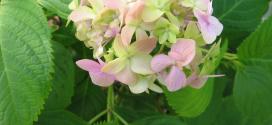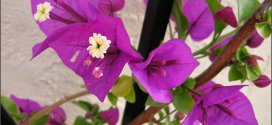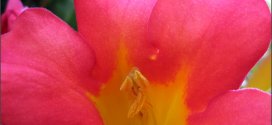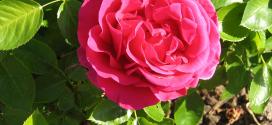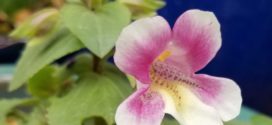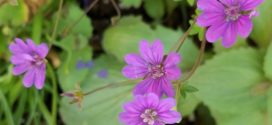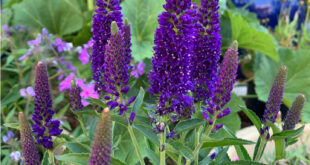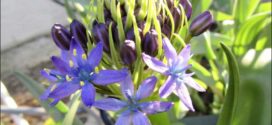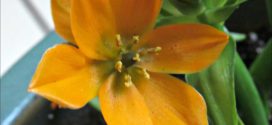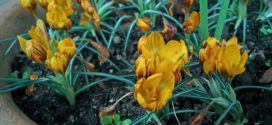Bigleaf Hydrangea, French Hydrangea. Up until recently, if you wanted a blue Hydrangea, you needed acidic soil; otherwise it was pink. Toxicity: Toxic to Dogs, Toxic to Cats, Toxic to Horses Toxic Principles: Cyanogenic glycoside Clinical Signs: Vomiting, depression, diarrhea. Cyanide intoxication is rare – usually produces more of a gastrointestinal disturbance. Family: Hydrangeaceae (hy-drain-jee-AY-see-ee) (Info) Genus: Hydrangea (hy-DRAIN-juh) (Info) …
Read More »Tag Archives: perennial
Bougainvillea
Bougainvillea . Very popular . You need at least a foot width of soil. I tried growing it in 3 inches but it did not grow well. Sunnyvale’s climate zone (9b) is right on the edge for this tropical plant. You should protect it from freezes. Read more: http://davesgarden.com/guides/pf/go/55375/#ixzz3HZrgOo3C
Read More »Red Trumpet Vine
Red Trumpet vine has lots of pretty red flowers. I am warning you that it is an aggressive climber. You can see an example at the intersection of Matilda and Sunnyvale-Saratoga Road. Another example is on the south side of Sunnyvale-Saratoga Road past Fremont just past the Falefal-stop restaurant. I have a plant growing in a 3-inch wide trench and …
Read More »Carpet Rose
Carpet Roses need no spraying, no staking and just a simple snipping to shape annually. (I recommend feeding them once or twice a season with time release fertilizer so they have the nutritional resources to produce huge volumes of blooms over the entire growing season.) The Carpet Rose is an excellent low maintenance plant for the Sunnyvale garden.
Read More »Mimulus naiandinus ‘Mega’
Abundant REALLY LARGE fanciful blooms appear Spring thru Summer on this new “Monkey Flower” variety from Chile. Twice the size of the original species (2” top to bottom), ‘Mega’s’ creamy white flowers are blushed cherry & garnished with a yellow throat & showy spots. Dark branching stems, refined blue-green foliage & a bushy 20” high & wide form completes the …
Read More »Geranium pyrenaicum ‘Bill Wallis’
Dozens of deep purple-blue blossoms in a small package (15″ tall x 20″). Reliably perennial, it happily self-sows to fill in bare spots with its ever-present color. When the flowers are spent (after months), cut back to 1”, side dress with compost & it’ll burst right back into bloom. BEST in rich soil & half day sun, but not required. …
Read More »Veronica
A blast of dense, vertical spikes that bloom for months in our mild climate – & then blooms again! Veronica longfolia “Vernique” is a hybrid version of this essential cottage perennial. It rises to 2 feet tall and 2 feet wide across bearing rich, purple, 6” spikes from late Spring to July, attracting mobs of butterflies, bees & hummers! Cut …
Read More »Scilla peruviana
Scilla peruviana is a evergreen perennial makes a spring-time statement with 50 to 100 deep-blue, starry blossoms atop large, cone-shaped flowers. Grow it alongside other spring flowering bulb crops such as daffodils, hyacinths and tulips. These unique flowers have an impressively long bloom time. Short dark green strap-shaped leaves emerge in the fall to form tight rosettes to 18 inches …
Read More »Ornithogalum
Bring a touch of Africa to your yard with the brilliant orange Ornithogalum dubium. Commonly called star of Bethlehem, orange star flower, snake flower or chincherinchee, this South African bulb is hardy in U.S. Department of Agriculture planting zones 7 through 11, and can be enjoyed as a tender bulb or a potted plant elsewhere. The plant grows up to …
Read More »Orange Monarch Crocus
Getting its name from gorgeous, bi-colored orange and near-black blooms that resemble a Monarch Butterfly, this Wild Crocus is sure to be one of the first to pop up and delight in the early spring. Growing to be only 3-4” high, plant this beauty somewhere in front where you can enjoy it! Snow Crocus are the earliest Crocus to flower, …
Read More »